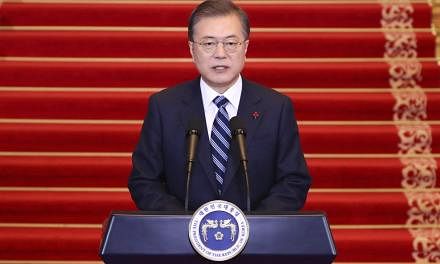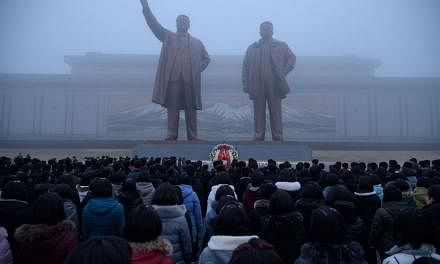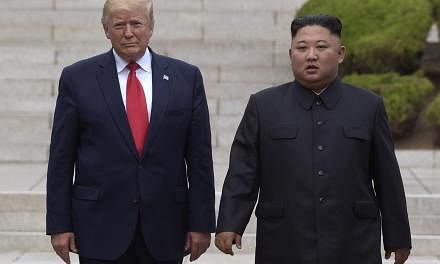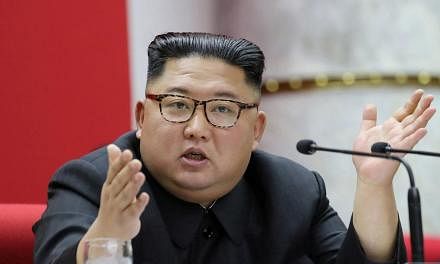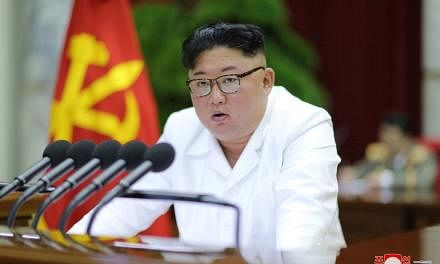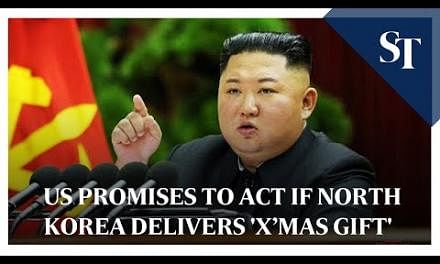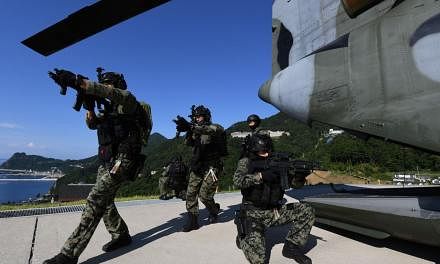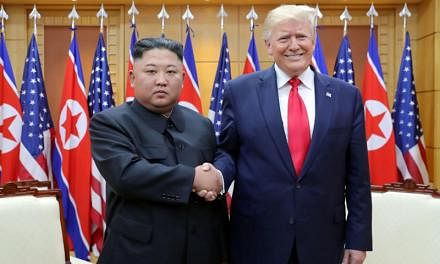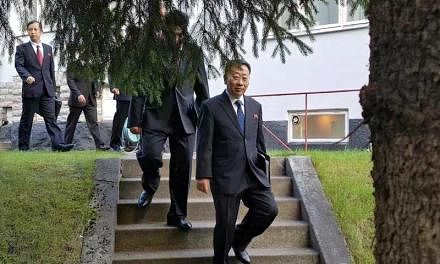SEOUL (NYTIMES) - When United States President Donald Trump sent a Twitter invitation last Saturday (June 29) to North Korea's leader Kim Jong Un to meet at the heavily fortified Demilitarised Zone (DMZ) separating the Koreas - "just to shake his hand and say Hello(?)!" - both men had much to gain, and more to lose.
If Mr Kim did not attend, even though his side had seemed intrigued, it would have embarrassed Mr Trump and opened him up to more criticism for his unpredictable diplomacy. It would also have compounded the dramatic failure of their summit in Hanoi, Vietnam, which Mr Trump abruptly called off in February.
But the North's leader showed up at the appointed time. Here are four takeaways from the historic encounter.
1. IT WAS NEAR PANDEMONIUM
The scene appeared to be chaotic at times, with video footage showing journalists and camera people scurrying around the two leaders, jockeying with security officials and elbowing one another to position themselves into the perfect spot to record the encounter.
And the North Korean security forces left bruises on the American side.
Ms Stephanie Grisham, the newly minted White House press secretary, had a trial by fire after she tried to facilitate the American television crew's entry into a building called Freedom House and emerged roughed up by North Korean officers, according to journalists and footage from the scene.
She can be heard saying, "no", "stop" and "need help here" as she is pushed and jostled by men in suits.
CNN reporter Jim Acosta said on Twitter that the encounter was described as "an all out brawl". Earlier, he said during a broadcast that he had experienced the same treatment when he was in Singapore for Mr Trump's and Mr Kim's first summit in 2018.
The unpredictable nature of the meeting at the DMZ and its security logistics could not be overstated, as at times, Mr Kim's bodyguards, grim-looking behind sunglasses, appeared to be straining to fully protect the North's leader. They seemed hemmed in by Western reporters, camera people and handlers from the US, North Korea and South Korea.
In addition, shouts of "Guys! Guys! Come on!" could be heard as photographers yelled for two North Korean cameramen to get out of the shot. The two were relentless in their mission to record their leader's meeting with Mr Trump - even if it meant blocking the other journalists.
2. THIS WAS MORE THAN A HANDSHAKE
The unexpected invitation that took Mr Trump's diplomatic corps by surprise while the President was attending the Group of 20 summit in Osaka, Japan, was a Hail Mary appeal that experts acknowledged paid off in symbolism - if not in immediate concrete gains.
It morphed from a tweet, to a handshake, to a historic 20 steps by an American leader into officially hostile territory: At 3.46pm local time on Sunday, Mr Trump became the first serving American president to cross the border and set foot in North Korea.
"Big moment, big moment," said Mr Trump, who patted Mr Kim several times on the back.
"It is good to see you again," a beaming Mr Kim told the President at the DMZ through an interpreter. "I never expected to meet you in this place."
After posing for photographs in a crush of international journalists, the two men walked back to the South Korean side amid a whir of cameras and had a bilateral meeting that lasted about an hour in Freedom House.
At the end, Mr Trump said the two men had agreed to send their negotiators back to the table to seek a long-elusive agreement on the North's nuclear ambitions. Mr Trump also said he would invite Mr Kim to visit him at the White House.
3. VIEWERS SAW A CLOSE-UP OF A BORDER WITH A GRIM HISTORY
During the meeting on Sunday, video footage showed intimate, colourful glimpses of a border sometimes called the last Cold War frontier.
Viewers caught sight of men holding a thick yellow rope, which apparently was used to corral journalists at the site.
Then there were the blue huts. The 4km-wide DMZ that has separated North and South Korea for decades is jointly overseen by the American-led United Nations Command and North Korea. The squat huts, which straddle the demarcation line, are painted powder blue in the colour of the UN.
Camera lenses offered close-up views of the barriers and markers in the "truce village" of Panmunjom - 51km north of Seoul and 146km south of Pyongyang, North Korea's capital - where officials signed an armistice in 1953 to halt the three-year Korean War.
The area is lined with mines and barbed-wire fences, though those were not as visible on Sunday. Combat-ready soldiers train deadly weapons at the other side. But on Sunday, it appeared to be overrun by journalists. As cameras homed in on the low concrete barrier that Mr Trump crossed to enter into North Korea, it hardly seemed daunting. But visitors have dared not cross the slab, for fear of being shot.
In 2017, a North Korean soldier defected to South Korea through the heavily guarded zone separating the two countries, leading to gunfire on both sides of the border. Closed-circuit television footage showed the soldier's dramatic dash through the Joint Security Area north of Seoul, the South Korean capital, on Nov 13.
The most notorious incident at Panmunjom happened in 1976, according to The Associated Press, when axe-wielding North Korean soldiers killed two American officers sent out to trim a tree that had been blocking the view from a checkpoint.
Washington sent nuclear-capable bombers towards the DMZ in response. Animosities eased after Kim Il Sung, the grandfather of Mr Kim Jong Un, expressed regret for the episode.
4. THE WORLD WILL BE WATCHING TO SEE WHAT COMES NEXT
The two leaders greeted each other like old friends on Sunday, with a beaming Mr Kim, 35, praising Mr Trump, 73, and with the American president offering effusive praise of the man many experts have called a brutal, mercurial dictator who has killed members of his own family.
"This has a lot of significance because it means that we want to bring an end to the unpleasant past and try to create a new future, so it's a very courageous and determined act," Mr Kim told reporters through an interpreter.
"I don't think this kind of surprise meeting would have happened without the excellent personal relationship between your excellency and me," he later told Mr Trump in Freedom House.
"If he didn't show up, the press was going to make me look very bad," Mr Trump said of Mr Kim, adding: "So you made us both look good, and I appreciate it."
Later, he said: "Certainly, this was a great day; this was a very legendary, very historic day."
Even as the meeting thrummed with the weight of a symbolic moment of reconciliation, Mr Trump is eager for a resolution to the stalled nuclear talks with North Korea as he heads into a re-election year. He clearly hopes it would be defined as a signature element that could boost his campaign.
But US intelligence agencies and analysts have concluded that North Korea "is unlikely" to give up its nuclear arsenal. Mr Kim has stoked an international crisis by launching missiles and projectiles - as recently as May - and threatening more nuclear weapons tests.
"Tomorrow, North Korea will still have nuclear weapons, and the US will still maintain sanctions," said Associate Professor Leif-Eric Easley, an expert of international studies at Ewha Womans University in Seoul.
Even Mr Trump, amid the lavish praise, injected a word of caution that anything concrete would materialise from his moment, saying: "It'll be even more historic if something comes out of it."

